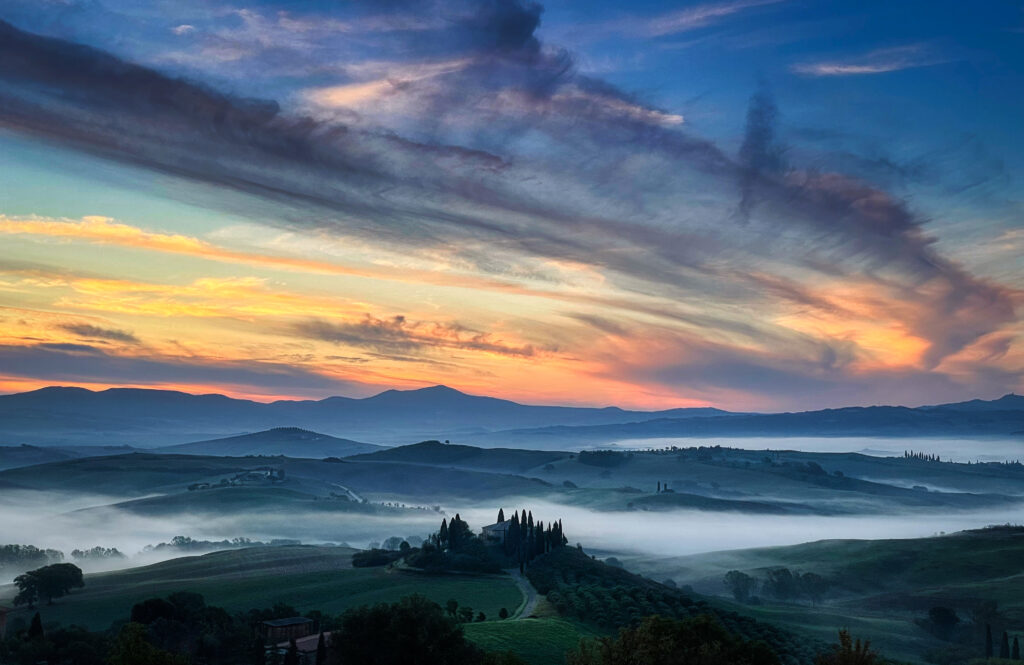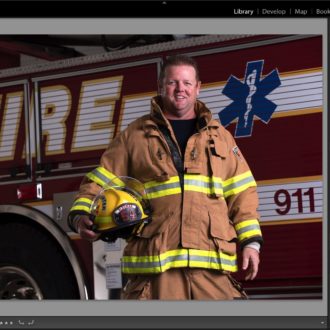This is an iPhone photo.

It’s not from the fancy new iPhone 14 Pro. It’s not even from a 13. It’s from an old iPhone 12 Pro. I shot it last week while recording a KelbyOne online course on shooting travel with your iPhone. I’m still amazed the camera on my phone can do what it does. I did edit the image in Lightroom (yes, those are the real clouds that were there that morning – no sky replacement), and that editing in Lightroom part is covered in Part 2 of my class – editing the images I shot in Part 1, all on Lightroom mobile on my phone and tablet.
Here’s what Canon, Sony and Nikon need to do
The low end of the camera market is all but gone. I can’t remember the last time I talked to someone who bought a point-and-shoot camera or even an entry-level DSLR. If I were Canon, Sony, or Nikon, I would release an official statement saying, “We make cameras for professionals. Period.” That’s it. Just make that statement, so instead of the public perception being “These companies are slowly dying,” they may be able to shift that perception to “They make high-end expensive lenses and bodies for professionals, and I sure would love to have one of those” instead of “Who needs a DSLR or Mirrorless camera when my phone camera is this good and getting better every day.”
Just a thought.
The OPTIC West Conference is almost here!

The folks at B&H Photo are bringing their awesome OPTICWEST Conference (The outdoor photo/video/travel imaging conference) out West for the first time. It’s coming to beautiful Monterey, California, on November 6-7, and I’m honored to be doing one of the keynote presentations (along with legendary National Geographic photographer, author, and speaker Frans Lanting) and an incredible team of instructors.
It’s an amazing event, which includes: a Whale Watching expedition aboard the Monterey Princess, with gear from Nikon, Sony, Sigma, and Canon available for you to borrow. There are Macro Photo Sets, a Workflow Pavilion where you can edit and print your work, and the OPTIC Challenge, where photographs can be taken at many natural sets professionally illuminated with Genaray Lighting. You can also enter your work in a gallery contest with prizes for the winners. There is an opening night cocktail reception and of course, lots and lots of great classes taught by that top-notch instructor team over the two days.
You can register to attend the in-person event or virtual online – here’s the link with info or to reserve your spot. After teaching at the OPTIC Conference in New York earlier this year, I can tell you – this is an event you absolutely do not want to miss.
It’s a Football Weekend!
Bama has a tough game against the Vols on Saturday, and the Bucs play Pittsburgh in a winnable game on Sunday (though historically, the Bucs lose super winnable games like this, so I’ll be holding my breath the whole time).
Hope your team wins this weekend (unless you’re a Vols or Steelers fan, of course). 😉
-Scott
P.S. Hoping to have an Adobe Express (formerly Spark) page ready for Monday to share the images from my Tuscany trip.



I agree with your statement that the all the camera makers should make only a pro line. Or at least all pro with maybe one entry level for those that want to learn?
I find myself (as a hobby photographer) looking more and more for lenses and bodies that are either Pro versions or one step down.
And I use my Pixel 6 to capture tons of images when that is all I have.
… “my phone camera is this good and getting better every day.” Indeed. But nobody is going to get “good and better every day” at making photos if it’s the camera that does all the work and the photographer just pushes a button and then “edits” everything in software. An iPhone has a camera that doesn’t need a photographer who knows what he is doing. An iPhone doesn’t help you learn something about POV, depth of field, or what a lens does to the image you see through the viewfinder. In short, “smarter” cameras make dumber, lazier, and worse photographers.
And by the way, there is no such thing as a “professional” photographer versus an “amateur” one. There are only good photographers and bad photographers, and some of those good ones and plenty of the bad ones earn money with their photography, but that is called “commercial” photography. Photography is not a profession but a form of art, even for the law, at least here in the EU.
[…] I shot it last week while recording a KelbyOne online course on shooting travel with your iPhone. I'm still amazed the camera on my phone can do what …View full source […]
Love your tips Scott, but sorry, I’m a Vols fan!!! Actually going to the game!!!! This year is the best chance of us beating Bama in many years so I’m hopeful!!! Gonna be a great game regardless!
I wish Apple was able to capture the dynamic range without having the raw file (or JPEG whatever model phone you’re using) look so tortured and manipulated. The midtones are so messy once all the algorithms get done doing your thing
The iPhone 14 Pro and 14 Pro Max have a 48mp sensor. When shooting RAW files with that sensor, the results are less processed. It really is quite amazing what Apple can do with such a small sensor that has a lot of pixels. I saw an interview with the lead software engineer for the iPhone cameras and he said traditional demosaicing did not give them satisfactory results, so they rebuilt the demosaicing process.